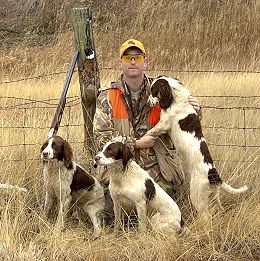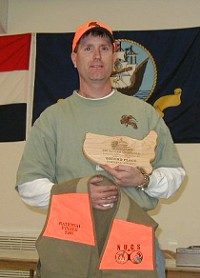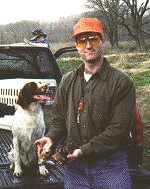  The National Upland Classic Series held its 2003 National Championship on March 10, 11 and 12, 2004. The Championship was held at the Robert E. Talbot Wildlife Area in southwest Missouri. The grounds, which are well kept by the Missouri Department of Conservation with row crops and natural warm season grasses, provided challenging fields for the participants. The weather cooperated through the first two days of the Championship, but then turned cold and dreary with periods of light rain during the afternoon of the finals.
The 2003 National Championship was my first "national" event to participate in, of any kind. I felt that the event ran smoothly and was well organized. It was evident that Hal Brown and Keith Nelson, Upland Classic founders, along with a whole host of other individuals, were prepared and qualified to hold a quality event. All the workers, from bird planters to judges to people running the registration table, did an excellent job doing what they needed to do to make the Championship a fun event to participate in.
I am new to this "dog game" known as tournament hunting. I have been fussing with English springer spaniels and have participated in both AKC Spaniel Hunt Tests and HRC Retriever Hunt Test with my spaniels. The Upland Classic events are just another avenue to enjoy my dogs and operate as a team to put birds in the bag. The basic criteria, should one boil down all the rules, would be that a dog needs to able to find birds. If not, then the rest does not matter. Secondly, the birds need to be produced in a manner that provides a shooting opportunity for the handler. Each handler has his own style of hunting and the shots that are within his comfort zone. I prefer the closer the better but not right on top of me.
The first part of the National Championship consisted of three runs: quail, pheasant and chukar. Each run consisted of three birds - only of the species for that particular field. For instance, my first run was in the quail field, second run was in the pheasant field and the third run was the chukar field. The committee did an excellent job of keeping the fields separated well enough to not have continued interference from any field. The grounds are large enough that extra fields were available should it have become necessary to make any changes in the finals.
"When the handler and dog team is experienced in the "game" and knows, for the most part, what to expect, then the team can concentrate on the field and getting their birds."
The top ten dogs were brought back for the finals run on Saturday, March 12, 2004. Some teams put together good runs through the preliminary runs but faltered in the finals.
Like any competition, the element of experience plays a big role in the competitiveness of some of the teams. When the handler and dog team is experienced in the "game" and knows, for the most part, what to expect, then the team can concentrate on the field and getting their birds. Just the process of getting to the correct field at the right time and knowing the process of how the event will run helps in calming nerves and enabling one to concentrate on the task at hand.
Flushing Doubles - 20 Entries:
Flushing Singles - 25 Entries:
Pointing Singles - 46 Entries:
Pointing Doubles - 37 Entries:
The competition was excellent and there were many teams pushing the leaders into the finals. As you can see by the final score of the top four placements, there could have easily been different names in the placements should a team have had a little faster run or not have missed a shot. However, in a tournament hunt, it is a team effort and anything can happen.
The three days were very exciting to me. On Wednesday night prior to the event, I got little sleep due to the excitement of getting to compete at the National Championship and wondering what to expect. After my second run on Thursday, which was a three bird, three shot run in eight minutes, I had one of the highest two run scores. So again, little sleep on Thursday night. On Friday, I ran the chukar field and had my third three bird, three shot run but it took me ten minutes. I knew I would be in the finals but where in the top ten did I end up? After all the runs were in, I was thirteen points out of first place but still in second place. So again, very little sleep on Friday night anticipating the final run on Saturday.
After the draw on Friday night, I knew that I would be the last person to run that was in the Top Five. I should know how everyone else did so that I would know what I needed to do to win.
The morning did not go as planned due to handlers running in both the Flushing Doubles and Singles event. When I was asked to run, I had to just concentrate on a clean run and try to get a fast time. Well, I ended with a three bird, four shot run in fifteen minutes. I left first place wide open for the leading team of Gibbs and Bear. Keith Gibbs and Bear did not leave the door open long and quickly put an end to the competition.
My doubles partner, Ron Wehner, put on a great run with his lab, Babe, and ended up in third place - only one point behind me. Ron and Babe also put on a good run in the Doubles and took fourth place.
The top teams in the Flushing Division all were highly competitive and put on some great shows of dog-handler team work to bag their birds. I did not get to watch the Pointing Division but I am sure the top teams were all as competitive as the Flushing Division.
I am primarily a hunter and would rather be hunting wild birds than competing in competitions. However, I will make plans during the 2004 season to work in an Upland Classic event due to the camaraderie, competition and excitement of a tournament hunt.

|
|
|
| Bookstore | The Bookshelf | Advertise on SJ | Classifieds | Resources | NEW! Events | Letters | Archives | Spaniel Journal | |


